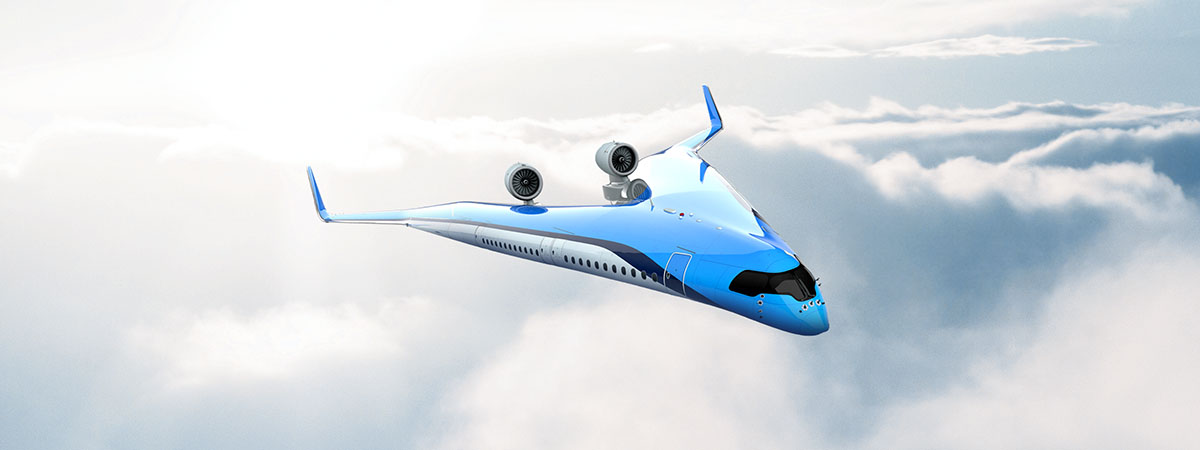For many rock lovers, the term Flying-V conjures up images of the legendary Gibson electric guitar. In 1958, the year it was designed, it was undoubtably futuristic.
In the last decade, we have dreamed of various concepts for the aircraft of the future: winged, electric, powered by solar energy, and more. They all revolve around efficiency, sustainability and cost-reduction. And, even though some people refuse to belief it, the future is closer than ever, demanding renewable energies, reduced greenhouse gasses, and more sustainable models – and all this, before it’s too late.
This commercial aircraft concept breaks with the traditional configuration and design of aircraft in search of greater efficiency, sustainability and cost-reduction.
With this in mind KLM Airline and TU Delft University are working together on their Flying-V scale model. In 2019 they presented their design. In July 2020 the first flying scale model made its maiden flight in Germany. Researchers have estimated a 20% reduction in consumption thanks to design and lightweight construction materials.
The Flying-V has two V-shaped fuselages, which are actually the wings, joined by the cockpit. The wings carry the passengers, cargo and fuel, in other words, practically everything. It is designed to transport 314 passengers, or up to 440 in a high occupancy configuration. However, that number depends on how each airline chooses to configure its planes. It will be 55 meters long and 17 meters high with a wingspan of 65 meters. From an airport point of view, an apron suitable for parking a modern A350 could also handle a Flying-V, complying with all safety requirements.
One feature that stands out is the absence of a separate horizontal tail plane. Stability is achieved via the wing’s aerodynamic centre, located behind the centre of gravity. On the other hand, pitch and roll is provided by the segmented elevons at the trailing edge of the outboard wing, while the yaw is provided by vertical rudders integrated in the winglets.
If we take a closer look at this flying scale model, we can see that it doesn’t have flaps either, which reduces production and maintenance costs. But what performs the function of the flaps? According to researchers, the Flying-V’s wing area is around twice that of the A350 and for that reason, it does not need additional high-lift elements. For landing, split speed brakes have been incorporated into the landing gear fairing that do not interfere with the aerodynamics of the wing, making it more efficient. Also, the landing gear has been made longer to have a greater angle of attack during take-off and can generate lift more quickly without the need for flaps.
And, what about the engines? They have been placed just behind the trailing edge of the wing, and the pylon on which the nacelle rests are attached to the main landing gear structure. As they are placed behind the wing, and therefore behind the passenger cabin, the noise will be reduced thus improving passenger comfort. The engines will be very efficient turbofan, and the developers intend to have the possibility of configuring the Flying-V with other types of renewable energy engines, which is the ultimate goal.
As for the interior of the cabin, this could vary greatly from the final model – if it happens in the next decade. Due to the position of the cabin in relation to the flight direction, the idea is to have rows of staggered seats, the benefit being individual armrests that avoid contact with other passengers. An alternative would be the famous table-for-four that we see in highspeed trains. For long routes, triple berths for sleeping would convert to three-seater benches for take-off and landing, or when the three passengers wish (this is designed for three people travelling together). Finally, there’s the possibility of a series of chaise lounge style seats hanging from the ceiling to have a greater reclining capacity.
The Flying-V flying scale model’s maiden flight last July was a smashing success that will make it possible to keep moving forward with this project. It revealed the following:
- Rotation during take-off was easy. The aircraft’s thrust was good, with speeds and flight angles as expected.
- The aircraft’s centre of gravity was located slightly further back than calculations had forecast.
- The current design has some “wobble”, known as “Dutch Roll” in aeronautics. This makes it difficult to keep the wings level and caused a rather rough landing. Aerodynamic calculations had predicted this but demonstrating this in an actual flight allows the team to adjust the aircraft accordingly.
Thanks to this first flight of the flying scale model, researchers can make modifications and continue performing tests in search of the safest and most efficient model. And, when the time comes, they can develop a full-size prototype.
During the process, in addition to researching the airworthiness of the aircraft, the impact on current airport infrastructures should be studied, for example turns on taxiways, connections with gangways etc. It will also be necessary to study the effect on passengers because most of them will be further from the axis of rotation in the roll maneuver than in any current aircraft. This could easily cause dizziness.
If studies and developments turn out well, it’s estimated that we could witness this aircraft’s first commercial flights in the 2030’s. And we could also be participants in a revolution of the commercial aeronautics sector.



